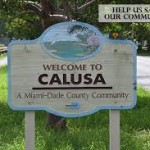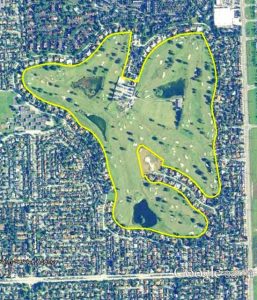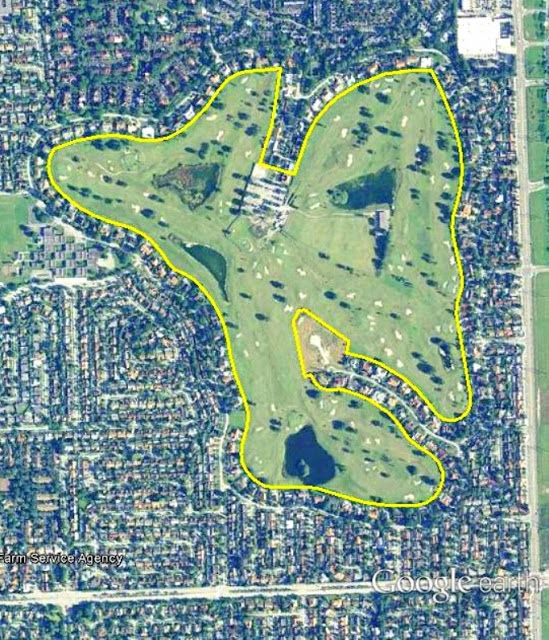A group of West Kendall residents in a longtime fight against the redevelopment of the  Calusa Golf Course won an important battle last week when the Miami-Dade Commission basically did nothing — and, effectively, killed a proposal to turn the 168 acres into more homes.
Calusa Golf Course won an important battle last week when the Miami-Dade Commission basically did nothing — and, effectively, killed a proposal to turn the 168 acres into more homes.
But Ladra has a feeling that the war is not over and the plan could come back from the dead.
And the whole ordeal has left us with little trust in a government land use and zoning mechanism called a covenant.
Developers want to turn the abandoned golf course in the Calusa community into 670 homes buffered by 100 feet of green space that also includes a bike and pedestrian path. They tried to buy the adjacent and opposing residents — and commission votes to transmit the request for a land use change to Tallahassee — with the promise of potential picnic pavillions, zen gardens, play lots and a dog park on the 3.5 mile perimeter loop.
But homeowners have consistently said they don’t want any of that. And they point to a 99-year covenant with 49 more years on it and say they bought their homes based on this promise that the county made that the golf course would remain a golf course unless 75 percent of the adjacent and affected homeowners agreed with a new plan.
That’s not close to happening and Commissioner Audrey Edmonson suggested it would not ever happen — but she  doesn’t know that. Commissioner Sally Heyman said their attitude is “We want a golf course and nothing else.” But they haven’t said that. Both of them called the development urban infill. In West Kendall. Really.
doesn’t know that. Commissioner Sally Heyman said their attitude is “We want a golf course and nothing else.” But they haven’t said that. Both of them called the development urban infill. In West Kendall. Really.
The residents are opposed to wt developers are presenting now because they don’t like the density, which could add between 1,000 and 1,500 cars to their roads daily. Ladra is certain they like the dog park and the other shiny bells and whistles. Who wouldn’t? There could be room for negotiating if they go down in density. They say they’ve already come down from 1,100 units — 481 single-family houses and 619 town homes — which has to have been a bait and switch because nobody can legitimately conceive of that many units there. The comparible properties are between 2.5 and .64 dwellings per acre, so that would mean a maximum of 210 dwellings, though residents probably want to see it closer to around 54.
So, maybe something in the middle? How about 100? Developers still stand to make a ton of money.
And add a clubhouse with an indoor gym and basketball court. Or a public pool. Make it a deal the adjacent residents can’t refuse.
That’s what Commissioner Xavier Suarez, Ladra is certain, had in mind when he first sugges ted delaying the vote on the application until May so that, perhaps, the developers and the residents could come to some kind of an agreement. But he got pushback on that from commissioners who preferred to transmit the application, which sends the proposed redevelopment to state agencies for whatever input they would have — which, in this case, seems minimal and inconsecuential.
ted delaying the vote on the application until May so that, perhaps, the developers and the residents could come to some kind of an agreement. But he got pushback on that from commissioners who preferred to transmit the application, which sends the proposed redevelopment to state agencies for whatever input they would have — which, in this case, seems minimal and inconsecuential.
Both Commissioners Bruno Barreiro and Jose “Pepe” Diaz kept insisting that they were only seeking more information, though Ladra is uncertain what kind of information any state agency could provide on the impact of the redevelopment of this golf course. At least, what kind of information that would be more important than the facts at hand. Namely, the covenant that homeowner after homeowner referred to as part of their property rights.
The whole time this golf course has been discussed, the conversation centers on the 99-year covenant? If you look up the word covenant in the dictionary, some of its synonyms, you will find, are contract, agreement, commitment, guarantee, pledge, promise, bond.
How can commissioners continue to talk about covenants on other projects when they come back and pretend that this one doesn’t exist? Commissioner Rebeca Sosa had some difficulty with an action that should have given each and every one of them great pause.
“Who’s going to trust us,” Sosa asked.
Exactly.
It forced Suarez to make a motion to deny the transmittal, which died in a tie vote and was not resurrected before the meeting ended, so it, in effect, goes back to square one.
Suarez said that out of 484 letters or emails he got about the controversial plan, 480 mention the covenant. So it’s ont like this obscure, real estate term that none of the homeowners really knew what it meant. Just getting 484 letters or emails against a project is enough of a message to tell commissioners what they should do, even without a covenant. Dozens of them have attended at least three public hearings to urge our county government to deny the request.
But it’s going to come back. Golf courses have become the next horizon for developers who snatch them up, have them rezoned and then build whatever they want on what was once a grassy view.
Nobody is saying that this has to remain a golf course, if that is truly no longer a feasable use. But if this comes back without the resident’s approval, how can we ever believe that a covenant on any development — including, for example, the American Dream megamall — will be worth anything at all if this one is broken?
We can’t. Any break of a covenant will further erode what little trust we have left in local government.

